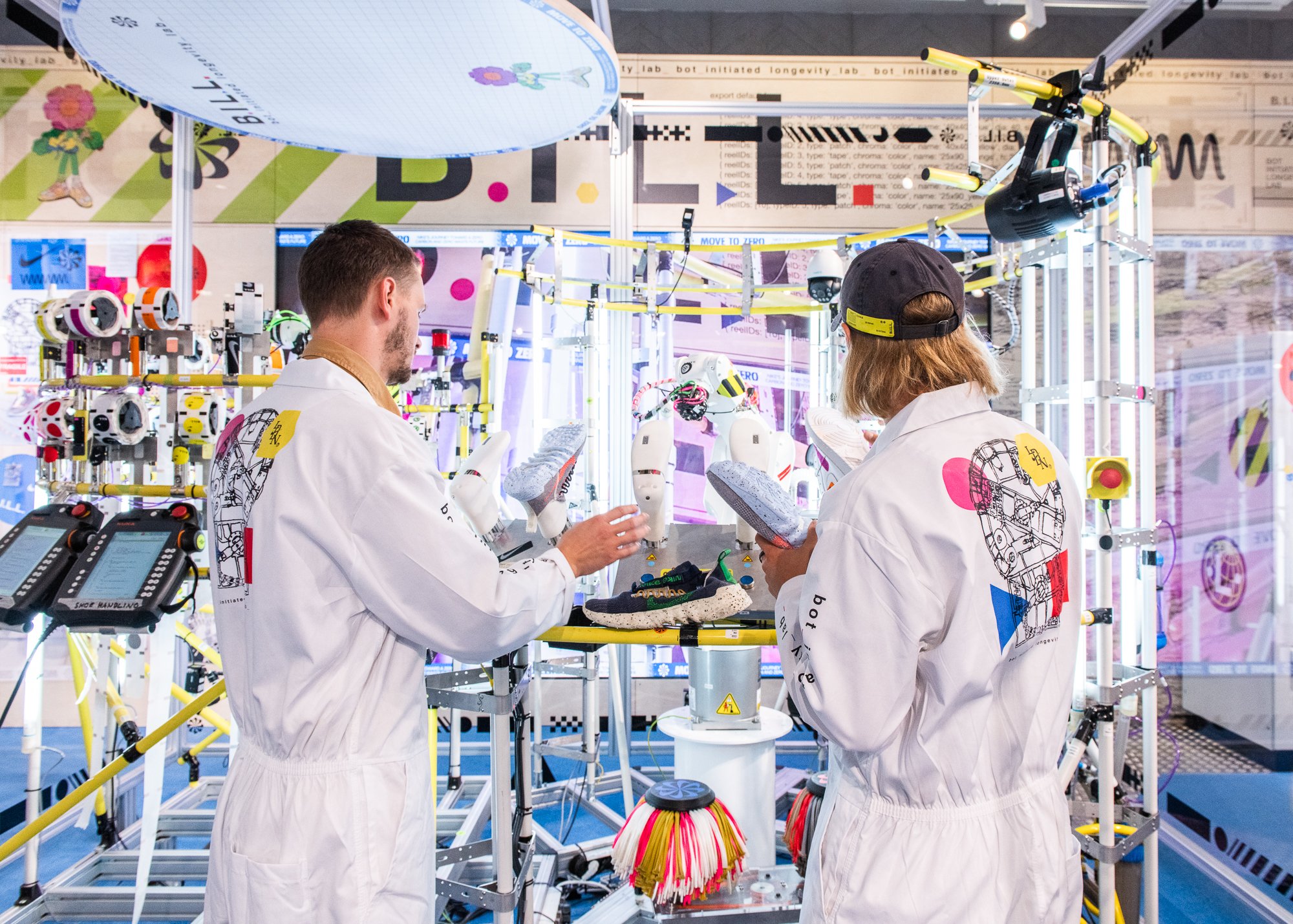A Clean B.I.L.L. of Health
B.I.L.L. installed at NikeTown.
B.I.L.L. is strange. They’re sort of a car wash, sort of an assembly line robot. They clean and repair shoes, that much I can tell you, but as to what they are – well, that I’m less clear on.
An acronym for Bot Initiated Longevity Lab, B.I.L.L. is a robot that has been installed in a corner of the NikeTown store in central London. Manned by technicians in white lab coats, B.I.L.L.’s basic form is a set of two robotic arms housed within a clear plastic perimeter wall, fuelled by electricity cables, computer feeds, and flexible pipes for detergent. When handed an old shoe to slot onto one of its robotic lasts, B.I.L.L. scans it to build a 3D model of what it’s working with, before proceeding to wash and dry it, and subsequently offer users a handful of customisation options (basically recycled polyester patches it can melt onto the shoe to cover any remaining areas of wear and tear). Finally, B.I.L.L.’s technicians thread in new laces and provide a fresh set of insoles. Oh, they spray it with some “new shoe” scent too.
All of which probably undersells the experience a bit. B.I.L.L. is fascinating and joyful to watch – a choreographed performance of robots twirling filthy shoes, meticulously scrubbing them clean and then gently hairdrying them. It would make for a fine set of TikTok videos, or else a compelling ASMR film, with the scratchy-scratchy sound of brush on shoe proving surprisingly soothing. In its hands (n.b., B.I.L.L. doesn’t have hands, but “in its robotic grippers” didn’t sound right) cleaning and repair become processes that are compelling and alluring. The act of restoring old shoes, as opposed to simply buying box fresh ones, is aestheticised in order to render it desirable. With the addition of B.I.L.L.’s brightly coloured patches, the shoes that eventually come out from the machine are refreshingly chaotic and asymmetrical – an aesthetic worth promoting if we are to live in a world in which repair thrives.
“The thing is, maintaining old product is deeply personal,” notes Noah Murphy-Reinhertz, sustainability lead for the Nike NXT team that has developed the project. “People will go to great lengths to care for their favorite shoes. Repairing a product is a way to extend our memory with a product. We see B.I.L.L. as a tool for being able to do that. Robots can do things that are tough to do by hand, but when we used robotics as part of a recycling technology, we still want the service to be personal.”
B.I.L.L. is a free service, albeit initially only open to Nike members who have booked an appointment, that forms a part of the company’s wider sustainability strategy. Nike states that it was responsible for the emission of 11,706,664 metric tons of CO2e in its 2020 financial year alone, for example, while its Move to Zero campaign aims to see the company become “zero carbon and zero waste” by 2050. A large part of the company’s response to these issues is in developing new materials and increasing the percentage of recycled content in its existing materials (which is covered in Disegno #34), but this strategy has frequently left the company open to charges of greenwashing. Given the volume of products that Nike produce, the creation of new, additional designs – even those designs which have superior environmental credentials to their predecessors – is likely to remain a source of critique.
It is in light of this that B.I.L.L. becomes of interest. The machine in its current state, for instance, is not a meaningful part of Nike’s sustainability strategy: the device is deeply performative, taking the best part of an hour to clean a pair of shoes, meaning that the number of pairs it can handle a day is severely limited. By design, B.I.L.L. is presently geared towards communication rather than scalable, rapid cleaning and repair, but it is nevertheless interesting to see Nike present an initiative focused around the restoration of existing products, rather than the purchase of new. Speaking informally during the machine’s press trial, for instance, Murphy-Reinhertz noted that while B.I.L.L. remains experimental – and its installation in London is a form of test to improve the technology, gather feedback and gauge public interest – its future development could begin to pose questions around whether Nike’s business model could pivot so as to reduce the central importance of the sale of new products. This would be a radical change and, in all likelihood, is not one that will happen any time soon, but it makes for a compelling thought experiment all the same.
In this sense, B.I.L.L. is not a fully fledged repair and cleaning service (even if it did do a nice job on the pair of trainers I fed it), but rather a kind of installation – a visually arresting performance whose operation raises worthwhile questions around the company that has created it and the wider potential for repair within commerce. There is undoubtedly a sense in which small-scale public initiatives of this kind can act as a fig leaf for Nike’s overall environmental impact, but B.I.L.L.’s potential as a piece of communications design is worthy of praise. Watching the robot lather, scrub and buff a pair of trainers is a positive reminder of the labour and materials that actually go into creating a product that is all too often perceived as throwaway. B.I.L.L. may only be putting a colourful patch over the problem of waste and overconsumption, but drawing attention to these issues is sometimes half the battle.
Words Oli Stratford
Photographs courtesy of Nike
B.I.L.L. can be found at NikeTown, 236 Oxford St, London W1C 1DE.




